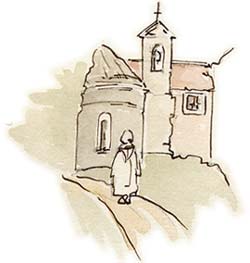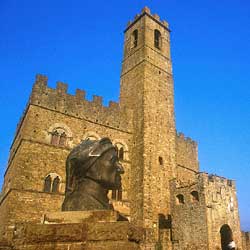| The Casentino is situated in north-east Tuscany on the
border with Romagna, its boundaries marked out by mountain ridges that
give it the appearance of a amphitheatre, through the centre of which
runs the river Arno (close to its source on Monte Falterona).
The Casentino is in the province of Arezzo
and includes the Parco Nazionale delle Foreste Casentinesi, which
can boast the most extensive and best-preserved woods in
Italy and the greatest variety of fauna in the whole of the northern Apennines.
The history of this region goes back to the Etruscans, who grasped
the economic importance of the area as a route across the Apennine
mountain chain. After the Roman era there were the barbarian
invasions which resulted in a period of decline and neglect. The medieval
period was the area's greatest moment of splendour and the Casentino
became an area of large properties and not just of transit. One of the
most powerful families in the area were the Conti Guidi, who ruled
a large chunk of the territory. There were also the Tarlati and Ubertini
families from Arezzo,
who owned the lands on the Arezzo
side, where they built a number of castles, for the most part destroyed
during the conflict between the Guelphs and the Ghibellines. And
at the crucial Battle of Campaldino, which marked the victory of
the Guelphs, there was also a young Florentine poet named Dante Alighieri.
Following the defeat of the Conti Guidi in the Battle of Anghiari
(1440), the Casentino became part of the Florentine Republic; subsequently
it passed under the control of the Medici, before finally being incorporated
into the Grand Duchy of Tuscany.

The hermitage of Camaldoli
Its marginal geographical position combined with its great natural beauty
attracted religious groups as a conducive location for prayer and meditation,
and they chose a number of beautiful, isolated sites to build monasteries,
hermitages, sanctuaries and country parish churches. One of the most
important of these is a sanctuary called La Verna, which was given
by Conte Cattani to St Francis, who lived there and received the stigmata
there in 1224. This place is almost supernaturally beautiful and
lies on a mountain that is protected and watched over by the monks, who
have managed to preserve its natural heritage intact to the present day.
Pilgrims and visitors still come to La Verna from all over the world.
The hermitage of Camaldoli was founded in 1023 by San Romualdo,
who was captivated by the beauty of the forest. Camaldoli is still
an internationally-significant religious point of reference and thousands
of pilgrims and visitors come here every year.
The earliest historical evidence of the Pieve di Romena at Pratovecchio
dates back to 1054. This country parish church is the most important
in the Alto Casentino and its artistic and architectural beauty give
it an aura of elegance and refinement.
 There
are still lots of castles in the Casentino, the most well-known
and best-preserved of which is at Poppi. The residence of
the Conti Guidi from 1100 to 1400, its imposing walls tower over
the village and dominate the plain of Campaldino. There
are still lots of castles in the Casentino, the most well-known
and best-preserved of which is at Poppi. The residence of
the Conti Guidi from 1100 to 1400, its imposing walls tower over
the village and dominate the plain of Campaldino.
The Castello di Porciano, which lies on a low hill together with
a medieval settlement, was also the property of the Conti Guidi,
and is a fine palace-tower that dominates Stia. It was here that
Dante wrote his famous letter to the Florentines in 1331.
It has recently been restored and now houses a small museum containing
various ceramic finds and tools and instruments that were part of the
local peasant farming culture.
Only the solid walls of the imposing fortress of Chiusi della Verna
now remain.
The Castello di Romena was built in the year 1000 and was the most
heavily fortified castle of the Conti Guidi, having three sets of walls
and fourteen towers. It dominated the whole Casentino valley,
and it's still possible to admire the layout of the castle and its well-preserved
main towers and keep. There is reference to it in Canto XXX of Dante's
Divine Comedy.
One of the most important towns in the Casentino is Stia,
which lies at the foot of Monte Falterona where the river
Staggia flows into the Arno. It developed in the medieval period
as a market for the Castello di Porciano, which overlooks it. It has a
very distinctive central piazza which lies on a slope and is surrounded
by covered arches. The town is famous for production of a very particular
and brightly-coloured form of wool called 'casentino', which
is known throughout the world. Another important town is Bibbiena,
which is the most economically significant settlement in the area due
to its textile and electromechanical factories. Despite a certain amount
of building and development over the last two centuries, Bibbiena has
managed to preserve its original historic town centre.
The isolated town of Poppi lies on a hill dominating
the Arno valley and is one of the most important towns in the Casentino.
It has Roman origins but its main development took place when the Conti
Guidi elevated it to the status of feudal residence in the 12th century
by building a castle there. This can still be seen today. Not far from
Poppi is the plain of Campaldino, where a famous battle was fought
between Firenze and Arezzo on 11 June 1289, which ended with the defeat
of Arezzo.
The Casentino is also well known for its cuisine and has
a number of characteristic dishes: tortelli alla Casentinese, which
are potato-filled ravioli served with a delicious meat sauce; scottiglia,
an extremely ancient and very tasty dish made from a variety of meats
cooked very slowly with the gradual addition of both, tomato and red wine;
lumache, snails cooked for a couple of hours in a rich sauce; and
finally panina, an original form of bread flavoured with herbs
and sultanas. And of course one absolutely must not forget the porcini
mushrooms from the forests of the area, the best in Tuscany.
Translated by Jeremy Carden
Picture by Sandro Santioli
|